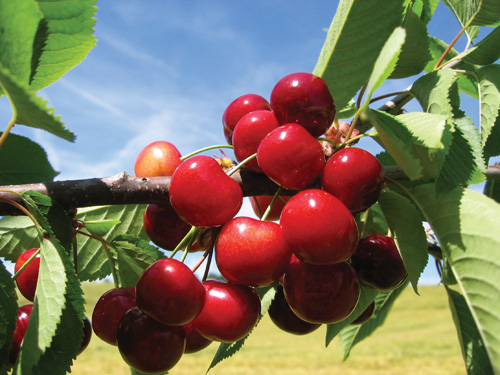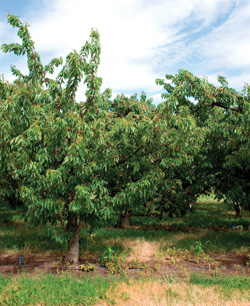
Features
Production
Research
Competition, land prices have B.C. cherry grower thinking twice
cherry grower thinking twice
March 13, 2008 By Peter Mitham
Though years of work renovating
his eight acres of cherries won him an award at last fall’s B.C. Fruit
Growers’ Association horticultural forum, orchardist Roy Kato is
weighing his options for the future.

Though years of work renovating his eight acres of cherries won him an award at last fall’s B.C. Fruit Growers’ Association horticultural forum, orchardist Roy Kato is weighing his options for the future.
Kato, now 59, points to rising property values in the Naramata, B.C., area, located just outside Penticton, which is currently a booming area for wineries and retirees, and wonders how much longer he wants to stay on the land. With new cherry plantings requiring five years before they reach full production, further improvements may fall to someone else.
“I’m getting to the age now, I’m thinking how much longer do I want to do this?” he says during a conversation this past winter. “The bench up here has just gone crazy because of the wineries. You get all these very wealthy people coming up here and it’s like they have money to throw away.”
With farm property values running in excess of $150,000 an acre, Kato’s dilemma isn’t unusual.
It’s a very different environment from the one he faced when he and his wife Kathy originally came to Naramata in 1980.
During the 1970s, the Katos operated an assay lab in Whitehorse, putting in long hours each summer testing rock samples for mining companies.
“I enjoyed the Yukon, but I wanted to get back to the warmth and good fruit,” says Kato, who grew up in Kelowna.
The Katos purchased a 10-acre orchard in 1981. The two five-acre parcels had apples and cherries at the time. Few of the original trees are still standing. Most of the apples and all of the cherries have been replanted to newer, more lucrative varieties that Kato has trained to become productive at an early age.
Kato’s replanting and management of his young trees, aimed at accelerating production, were part of the reason he was selected for the soft fruit award at the 2006 BCFGA Hort Forum in November.
“I’ve done quite a bit of tree training with them to try to get them to fruit up quickly,” he says. “I do a lot of scoring of the tree itself to promote branching. When you score, you get a softer branch coming out; it’s not quite as vigorous.”
The less vigorous branch is then trained to grow at a more horizontal angle, enhancing fruiting.

The idea came to Kato from his work with apples and experiences with spindle-type plantings, which he initially observed in Europe. He has adapted the training method to cherries with good success.
Kato also pays attention to nutrition to ensure productivity is up to snuff.
His trees have responded, producing large fruit that Kato says sells successfully in Asia, a place where growers can command better prices. The experience underlines a shift in the importance of producing quality fruit, he adds, noting that it is becoming increasingly critical to the health of markets.
He points to the downturn in cherry prices this past summer. Though it was largely attributable to fruit from the U.S. and Canada reaching the market at the same time, there were also quality issues. Allegations of consignment selling of low-quality fruit by American shippers were widespread, fuelling talk of action against the U.S. industry.
Kato says such attempts to move low-quality fruit help no one.
“If they start doing that, they’re just going to totally kill the market for everybody,” he says.
Kato believes the future for growers who have the right cherry varieties is good, however.
He has replanted his cherry orchard to new, late-season varieties such as Sweetheart and Staccato, which mature in mid-August.
While he is considering Sovereign and Sentennial, two new releases from Agriculture and Agri-Food Canada’s Summerland, B.C., research station, whether or not he plants them will depend on how much longer he plans to keep farming.
Moreover, while average farm gate prices for cherries were running at $1.61 a pound in 2005 – compared to $1.15 a pound in 1996 – Kato feels the market may be near its peak.
“I wish I had gone all to cherries 15 years ago, but I think it’s almost too late now,” he says. “I think the prices are going to start going down.
“In the United States, they’ve put in tons of acreage and all over the world, there’s going to be a pretty big glut, I think.”
Northwest Cherry Growers reports that the cherry acreage in Washington State currently stands at about 32,000 acres, with the 2006 pack-out running 30 per cent above 2005 numbers. B.C. growers have seen a similar increase, with most of the 2,655 acres of cherries in the province having been planted with assistance from the province’s 16-year-old orchard replant program.
| Garlic hope in infection fight Garlic has been hailed a wonder drug and used for centuries to prevent gangrene, treat high blood pressure and ward off common colds, and may even have cancer-fighting properties. Now, scientists at the University of Nottingham in the U.K. are leading a new study to see if the pungent bulb holds the key to preventing cystic fibrosis patients from developing a fatal infection. The research will look at whether taking garlic capsules can disrupt the communication system of the pathogen Pseudomonas. During the study, half the volunteer CF patients will be given garlic capsules, while the other half will receive a placebo (olive oil capsules) over a two-month period. At the beginning and end of the study, researchers will measure the levels of germs in patients’ sputum samples, the patients’ lung function and weight will be monitored and blood tests carried out to ensure the garlic capsules are safe. Cystic fibrosis is an inherited condition that causes difficulties in digesting food. Children may be slow to put on weight and grow properly. Both children and adults with the condition are vulnerable to repeated and chronic chest infections that damage the lungs and may be fatal. |
Print this page